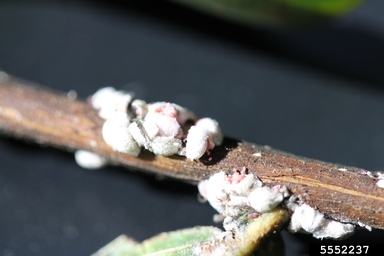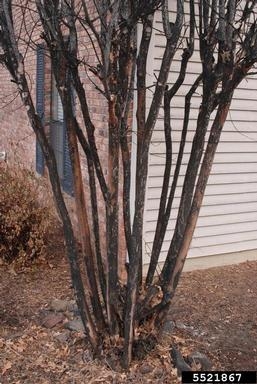Crape-myrtle Bark Scale
Crape-myrtle bark scale (CMBS; Acanthococcus lagerstroemiae; Hemiptera: Eriococcidae) is an emerging invasive pest of crape myrtle in Virginia. Originally from Asia, CMBS has spread across the southeastern United States, probably through the movement of infested crape myrtle stock in the nursery trade. CMBS was first detected in Chesapeake in 2014, and then first detected in the Richmond area in 2020. Consequently, this pest has spread in the Richmond area from infested nursery stock to long-established plantings. So, while it may be new to us in the RVA, we have some experience with this pest in other parts of the state.
CMBS is a pinkish scale insect that produces a layer of whitish-gray waxy material that thickens as the scale matures (Fig. 1). Heavily infested Crape myrtles may have trunks and branches encrusted with layers of CMBS.
There are 2-4 generations of CMBS each year in the more southern regions of the US. In Virginia, CMBS appears to have at least two generations per year based on samples submitted for identification. More research is needed to determine the timing for treatment of the more vulnerable crawler life stage.
Damage
CMBS produces copious amounts of honeydew, which supports the growth of sooty mold. Crape myrtles with heavy coverings of sooty mold may have blackened trunks and branches (Fig.2). Its honeydew can also coat vehicles, other plants, and structures near and under infested trees, also attracting bees, wasps, and ants.
CMBS does not appear to kill healthy crape myrtles quickly, but it is a strong stress factor on the trees. Crape myrtles infested with CMBS tend to leaf out later in the spring; have fewer, smaller bloom clusters; and have reduced plant vigor, all of which diminishes the attractiveness of this popular ornamental tree.
Fig. 1. Crape-myrtle bark scale (Acanthococcus lagerstroemiae) adults and eggs. Photo credit: Helene Doughty, Virginia Polytechnic Institute and State University, Bugwood.org

Fig. 2. Crape-myrtle bark scale (Acanthococcus lagerstroemiae) sooty mold damage. Photo credit: Jim Robbins, Univ. of Ark. CES, Bugwood.org.

Control
Avoid buying infested plants from garden centers and nurseries.
Plant crape myrtles properly in full sun, which discourages establishment of CMBS.
Maintain plant health, but do not apply too much nitrogen fertilizer (particularly from turfgrass applications), which may encourage scale populations.
Examine infested plants for ladybird beetles feeding on CMBS. Naturally occurring predators can drastically reduce CMBS infestations. Immatures of this ladybird beetle are covered with a white fluffy covering and are often mistaken for CMBS. Keep in mind that you will find these immatures moving along the infested tissue. In contrast, CMBS will not move once settled after the crawler stage.
For current chemical control recommendations in Virginia, view publication 456-018: Home Grounds and Animals Pest Management Guide (https://www.pubs.ext.vt.edu/content/dam/pubs_ext_vt_edu/456/456-018/ENTO-523.pdf) (page 4-54 of the 2023 edition.)
Consider lightly pruning flower clusters and branches heavily infested with CMBS before spray treatments. Bag those infested plant materials before disposing them.
Do not apply insecticides when pollinators or predatory ladybird beetle adults or larvae are present.
This technique can be used to asses if a control treatment was effective or not: check for live CMBS by running a fingernail over the scales and looking for a pinkish-red fluid. Dead scales will be dry, but their white bodies may persist on the trunk and branches of crape myrtle until they weather off.
Fig. 3. Crape-myrtle back scale and ladybird beetle larva. Photo credit: ©Edward R. Olsen, Virginia Cooperative Extension

Other plants affected by CMBS
There have been reports of this insect moving beyond the primary host, crape myrtle, to other ornamental plants such as spirea, American beautyberry and hypericum. Low-growing spirea and hypericum cultivars are often found growing under or near crape myrtles in the landscape.
FAQ's for CMBS
Thank you to Dr. Alejandro Del-Pozo, Assistant Professor of Entomology, Department of Entomology, Hampton Roads Agriculture and Research Exension Center, Virginia Tech for providing answers.
I’ve heard of Crape myrtle disease, is that something different?
Some information on the web refers to CMBS as the ‘crape myrtle disease’. This is inaccurate, since CMBS is an insect and not a disease. Expected diseases on crape myrtle could be powdery mildew or leaf spots, both originated from different fungi.
I see recommendations for use of chemicals that are classified as neonicotinoids (imidacloprid or dinotefuran). Aren’t those harmful to bees? When I can I safely use them?
There is literature presenting information on the sub-lethal effects of neonicotinoids on bees. However, a direct exposure of any insecticide, including neonicotinoids, for bees will be harmful. Therefore, insecticides toxic to bees will contain mitigation information for their application, presented at the ‘bee box’ of the label. Following those practices is the law. Avoid applying any foliar insecticide when crape myrtles are blooming. Drenching at the base of the tree will be a safer approach to bees and other non-target organisms, when compared to a foliar application.
Will CMBS kill my Crape myrtle?
It is expected that even heavy infestations of CMBS will not kill a whole tree. However, significant infestations of this pest may cause branch die back. Therefore, a whole tree will get really stress if a heavy infestation of CMBS is left unmanaged. Heavy infestations of CMBS for multiple year might result in killing multiple branches of the tree.
How do I get that black stuff of my tree?
You could try to hand / pressure wash those moldy trunks with soap. The amount of labor necessary to do that could be, sometimes, cost prohibited at the commercial level. Avoid buying any type of fungicide to ‘kill’ that mold. The most effective tactic to reduce the presence of sooty mold is lowering the numbers of CMBS on the infested tree.
If I treat now, will my trees get re-infected?
Most of the neonicotinoid treatments will provide up to one year of protection. It is possible that re-infestation may happen after the insecticide treatment wears off. Constant monitoring for the presence of this pest is crucial for the timing of any insecticide application.
Are CMBS the reason that my car/deck/patio furniture is covered in something sticky?
Yes, it is. CMBS excretes significant amounts of honey dew. This dew is a highly concentrated sugar solution. Since CMBS is tapping on the phloem of the infested tree, it will filter the ‘good nutrients’ from all the sugar. That excreted honey dew gets deposited on surfaces and dries out becoming a shinny and sticky cover layer.
There aren’t any new plantings of crape myrtles near my tree, so how did my tree get CMBS?
CMBS crawlers, the first tiny instar / immature of this insect, gets blown by the wind and carried over through some distances. It is possible that those wind-blown crawlers might have landed on your tree, starting an infestation when settled.
Can I release ladybird beetles to control CMBS?
It is likely that releasing adults of a ladybird beetle may result in seeing them flying away from the release site. It would be recommended to release immatures of a selected predator, since they will not be able to fly away. Lacewing larvae could be an option for lowering CBMS populations. If interested in releasing beneficials, check out the list of some insectaries in the US where you could purchase them https://www.pubs.ext.vt.edu/content/dam/pubs_ext_vt_edu/ENTO/ento-480/ENTO-480.pdf.


